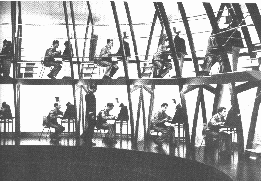 (1984, version of 1956)
(1984, version of 1956)
The anti-utopia
A futuristic anti-utopia is an utopia in which modern man has no place.
In "1984", published in 1949, Orwell states that if one agrees to live according to the doctrines imposed by the Big Brother, then living in Oceania is living in ecstasy. The same is true for those who live in the new England described by Aldous Huxley in "Brave New World", written in 1932. Of course those images were made exactly not to be agreed with. They show the technological future in a radical way: an absolutely efficient dictatorship, the ability of observing every citizen 24 hours a day, utter submission to the State, total lack of privacy etc. "1984" has two versions in film. In the first one (1956), the end of the story was changed to comply with the Cold War. Instead of surrending to the State, Winston Smith dies thundering against the Big Brother, in the name of freedom. However, the visual impression Orwell wanted to give was preserved.
The holocaust
Summing up, we can say that the toys built by man can lead him to an abyss. The consequence is war and the end of civilization. After that, one has either renewal or barbarism. However, images of a possible renewal are increasingly rare. In the movie "Things to Come" (directed by William C. Menzies in 1936 and written by H.G.Wells), the world is totally destroyed and rebuilt within 100 years. The scenes of destruction foresee what would be current in "Mad Max". The predominant image today is that of eternal barbarism. The style that emphasizes the "period of destruction" emerged in the 1980's with movies such as "The Day After", "The Testament", and "Threads".
The world going worse
The cities
The architecture of the future has already been defined as "Neo-Mayan". In the photo of "Just Imagine" we can see the 1980's NY from the perspective of the 1930's. In "Metropolis" part of this "Neo-Mayan" city is located on the surface, while the poor live underground. Just like Wells wrote in his work. In "Things to Come ╠" the whole city is under a cover and one of the rulers recalls the previous century (the 20th) as the end of the "Era of the Windows". After all, with the advent of technology, what is the use of having natural light?
 Reconstruction after the war, in Things to come (1936). MPEG (420k).
Reconstruction after the war, in Things to come (1936). MPEG (420k).
Transports
A sign common to all representations of the future is the individual flying device. This is an aspect of the 19th century dreams which movie
directors have kept. In a movie produced in 1939, Buck Rogers is rescued from the leftovers of his dirigible, in 2440, and taken by a rocket to the safety of Hidden City. Fifty years later, this characteristic is still present in movies like those of the series "Back to the Future 2".
 Buck Rogers and his rockets (1939). MPEG (63k).
Buck Rogers and his rockets (1939). MPEG (63k).
The war
Fighting in an "industrial army" can be as lethal as fighting a war. "Metropolis" shows the factory as an idol that feeds itself on the workers. The main character, in a spell of insanity, looks at the central machine and shouts "Moloch! ╠". It does not matter how one sees the future, it is a known fact that there is no room for individual manufacturers. Even in the
not so gloomy "Things to Come", everything is done in gigantic scale, with men acting as mere machine watchers. It is the idea of the "large automaton" proposed by Ure that prevails in the way work is seen in the future.
 The war in the future, in Things to come (1936). MPEG (301k).
The war in the future, in Things to come (1936). MPEG (301k).
Back to article's cover screen

Back to this week index

Back to mainmenu (trilingual)
⌐ NEO Magazine 1995
 Reconstruction after the war, in Things to come (1936). MPEG (420k).
Reconstruction after the war, in Things to come (1936). MPEG (420k).
 (1984, version of 1956)
(1984, version of 1956)




